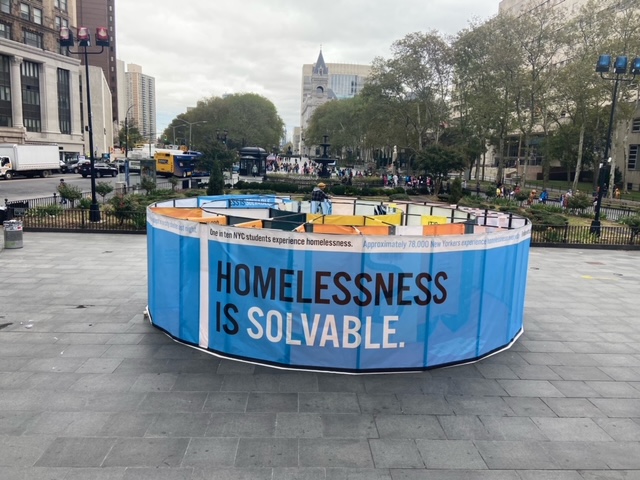RxHome, the organization behind the project, said the spiral maze is intended to show those who have not experienced homelessness or housing instability the various hurdles to finding a home, while illustrating the real-life experiences of thousands of local families.

Adi Talwar
The PATH building in the south Bronx, where families go to apply for shelter in the DHS system, only one of several places homeless New Yorkers can end up.This nightmarish public art project has nothing to do with Halloween.
An interactive installation opening Friday outside Brooklyn Borough Hall takes visitors through the bureaucratic, time-consuming and demoralizing process of moving through the city’s homeless shelter system on the way to permanent housing.
RxHome, the organization behind the project, said the spiral maze is intended to show New Yorkers who have not experienced homelessness or housing instability the various hurdles to finding a home, while illustrating the real-life experiences of thousands of local families.
“It will help educate a lot of people because there are a lot of misconceptions with homelessness,” said RxHome volunteer Tiffany Griffin, who experienced homelessness as a child before moving from a family shelter to a NYCHA apartment. “This will show the different levels people have to go through in the system.”
The labyrinth is entitled The Way Home and features 12 spaces specifically designed to highlight the obstacles encountered by tens of thousands of homeless New Yorkers—including the 8,579 families with 14,886 children currently staying in a Department of Homeless Services (DHS) shelter, city data shows. The vast majority of those families are headed by single Black or Latina mothers, according to the Family Homelessness Coalition (a City Limits sponsor).
One room in the exhibition details the various criteria shelter residents must meet to see if they qualify for rental assistance. Another illustrates the long waits, red tape and laborious search for a landlord willing to accept a housing voucher. Before exiting the maze—moving into a permanent apartment—visitors confront questions in a “Reflection Space,” among them: What does ‘home’ mean to you? And what policies should New York City adopt to end and prevent homelessness?
“We want people to see homelessness is the one problem we do have that we can solve,” said Shamaya Morris, another RxHome volunteer who experienced homelessness as a teen and as a parent of four children. Morris said she was displaced once again after Hurricane Ida flooded her Bronx basement apartment. She’s currently staying with her uncle and seeking to avoid a return to a city shelter as she looks for a new home.
She urged the city to facilitate more truly affordable housing and to convert commercial space and hotel rooms into homes—an initiative top leaders say they back, but has yet to get off the ground.

RxHome
The exhibition will open at Columbus Park, near Brooklyn Borough Hall before moving to Astor Place from Nov. 3 to Nov. 7Families and individuals in DHS shelters account for just a fraction of the larger population of people without stable housing. Thousands of New Yorkers live in public spaces, in shelters for young adults or temporary residences for survivors of domestic violence; an untold number of people stay in precarious housing situations where their names do not appear on a deed or lease. More than 100,000 New York City public school children experienced homelessness at some point during the 2019-2020 school year.
Though the number of families living in DHS shelters has decreased significantly over the past few years—thanks to provider efforts, rental assistance vouchers, stronger tenant protections and a COVID-driven freeze on most evictions—the average length of stay has risen to 520 days, the equivalent of nearly 18 months, according to the annual Mayor’s Management Report.
The exhibition’s creators and funders say The Way Home can help the next mayor, the incoming cohort of city councilmembers and everyday residents better understand the homelessness problem and understand the need for more truly affordable housing.
“New Yorkers across the city see homelessness as a crisis, and we want to make sure they understand not just the breadth of the problem, but also how exactly their elected leaders can fix it,” said RxHome Director of Organizing Asia Thomas. “The realities of homelessness are too often invisible, and we hope this maze helps New Yorkers see just how many families are struggling and use what they learn to spark conversations with their own kids and families around their dinner tables.”
The RxHome exhibition will open at Columbus Park, near Brooklyn Borough Hall before moving to Astor Place from Nov. 3 to Nov. 7.
Jason Cone, the chief of public policy at RxHome sponsor Robin Hood Foundation, noted that the city’s likely next mayor works nearby the initial location.
“I hope Eric Adams takes the opportunity to step outside his office and experience that exhibit,” he said. “It would go a long way to beefing up understanding of how the city’s policies are exacerbating the problems.”









